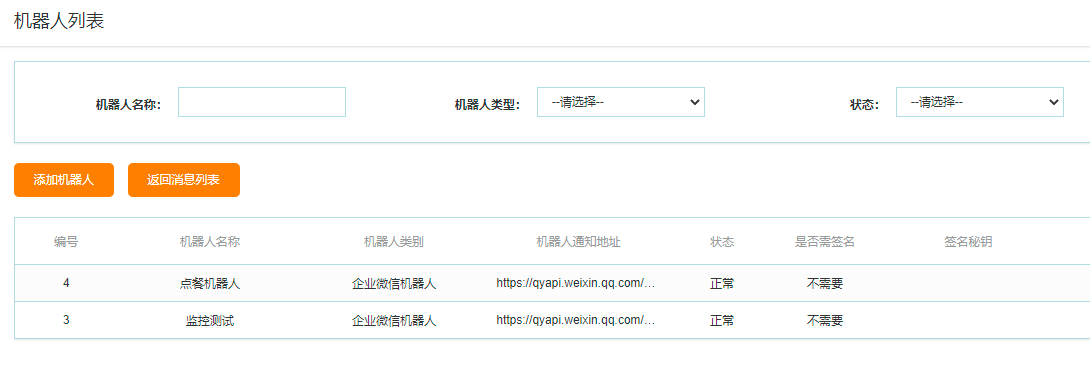软件工程
企业微信机器人自动消息发送webhook接入代码
本文主要是介绍企业微信机器人自动消息发送webhook接入代码,对大家解决编程问题具有一定的参考价值,需要的程序猿们随着小编来一起学习吧!
主要代码类如下
package com.test.common;
import java.io.IOException;
import java.text.SimpleDateFormat;
import java.util.ArrayList;
import java.util.Date;
import java.util.HashMap;
import java.util.List;
import java.util.Map;
import org.apache.http.HttpResponse;
import org.apache.http.client.ClientProtocolException;
import org.apache.http.client.methods.HttpPost;
import org.apache.http.entity.StringEntity;
import org.apache.http.impl.client.CloseableHttpClient;
import org.apache.http.impl.client.HttpClients;
import org.json.JSONObject;
/*
* 文件名:com.test.common;.SendRobotMsgUtils.java
* 简述:TODO
* 详述:
* 新建时间:2022年5月2日 下午12:31:41
* 修改内容:[新增]
* 修改时间:2022年5月2日 下午12:31:41
* 版本:1.0
*
*/
public class SendRobotMsgUtils {
@SuppressWarnings({ "rawtypes", "unchecked" })
public boolean wechatRobotTxtMsg(String webhookUrl,String msgContent,List<String> mentioned_mobile_list) {
boolean falg=false;
//webhook地址
String msgtype="text";
HttpResponse response=null;
try {
if(webhookUrl!=null&&msgContent!=null) {
HttpPost httpPost=new HttpPost(webhookUrl);
CloseableHttpClient httpclient=HttpClients.createDefault();
httpPost.setHeader("Content-Type", "application/json; charset=utf-8");
Map<String,Object> param=new HashMap();
param.put("msgtype",msgtype);
Map<String,Object> param_msg=new HashMap();
param_msg.put("content", msgContent);
if(mentioned_mobile_list!=null&&mentioned_mobile_list.size()>0) {
param_msg.put("mentioned_mobile_list", mentioned_mobile_list);
}
//封装消息体
param.put(msgtype, param_msg);
String txtmsg=JSONObject.valueToString(param);
System.out.println("*************执行前txtmsg:"+txtmsg);
StringEntity entity = new StringEntity(txtmsg, "utf-8");
httpPost.setEntity(entity);
System.out.println("*************执行前:"+httpPost.toString());
response=httpclient.execute(httpPost);
if(response!=null&&response.getStatusLine()!=null&&response.getStatusLine().getStatusCode()==200) {
String responseStr=response.getEntity().toString();
falg=true;
System.out.println("*************执行结果:"+responseStr);
}
}else {
System.out.println("*************输入参数为空********************************");
}
} catch (ClientProtocolException e) {
e.printStackTrace();
} catch (IOException e) {
e.printStackTrace();
}
return falg;
}
@SuppressWarnings({ "rawtypes", "unchecked" })
public boolean wechatRobotMarkdownMsg(String webhookUrl,String msgContent,List<String> mentioned_mobile_list) {
boolean falg=false;
//webhook地址
String msgtype="markdown";
HttpResponse response=null;
try {
if(webhookUrl!=null&&msgContent!=null) {
HttpPost httpPost=new HttpPost(webhookUrl);
CloseableHttpClient httpclient=HttpClients.createDefault();
httpPost.setHeader("Content-Type", "application/json; charset=utf-8");
Map<String,Object> param=new HashMap();
param.put("msgtype",msgtype);
Map<String,Object> param_msg=new HashMap();
param_msg.put("content", msgContent);
if(mentioned_mobile_list!=null) {
param_msg.put("mentioned_mobile_list", mentioned_mobile_list);
}
//封装消息体
param.put(msgtype, param_msg);
String txtmsg=JSONObject.valueToString(param);
System.out.println("*************执行前txtmsg:"+txtmsg);
StringEntity entity = new StringEntity(txtmsg, "utf-8");
httpPost.setEntity(entity);
System.out.println("*************执行前:"+httpPost.toString());
response=httpclient.execute(httpPost);
if(response!=null&&response.getStatusLine()!=null&&response.getStatusLine().getStatusCode()==200) {
String responseStr=response.getEntity().toString();
falg=true;
System.out.println("*************执行结果:"+responseStr);
}
}else {
System.out.println("*************输入参数为空********************************");
}
} catch (ClientProtocolException e) {
e.printStackTrace();
} catch (IOException e) {
e.printStackTrace();
}
return falg;
}
public static void main(String[] args) {
SendRobotMsgUtils srmu=new SendRobotMsgUtils();
SimpleDateFormat sdf =new SimpleDateFormat("yyyy-MM-dd HH:mm:SSS");
String nowstr=sdf.format(new Date());
String webhookUrl="https://qyapi.weixin.qq.com/cgi-bin/webhook/send?key=c17661d0c2e6";
String msgContent="监控机器人-普通文本消息\n消息时间:"+nowstr+";\n交易日期+支付渠道+渠道笔数+当日总笔数\n"
+ "你们所有人可以关闭此群消息!!!";
List<String> mlist=new ArrayList<String>();
mlist.add("@all");
mlist.add("18688888888");
// srmu.wechatRobotTxtMsg(webhookUrl,msgContent,mlist);
String msgmkContent=
"<h2>监控名称</h2>\r\n" +
" <tr style=\"border: 3px ;border-color: black;\">\r\n" +
" <th width=\"25%\">编号</th>\r\n" +
" <th width=\"25%\">用户名</th>\r\n" +
" <th width=\"25%\">姓名</th>\r\n" +
" <th width=\"25%\">联系电话</th>\r\n" +
" </tr>\r\n" +
" \r\n" +
" <tr>\r\n" +
" <td style=\"border: 3px ;border-color: black;\">01</td>\r\n" +
" <td >张三</td>\r\n" +
" <td >姓名</td>\r\n" +
" <td >18688888888</td>\r\n" +
" </tr>\r\n" +
"\r\n";
srmu.wechatRobotMarkdownMsg(webhookUrl, msgmkContent, mlist);
}
}
实际开发完成的功能效果可以访问:https://www.onekbit.com/wechatrobotinfo/selectlist.do 体验使用。
使用微信机器人定时群发消息:
这篇关于企业微信机器人自动消息发送webhook接入代码的文章就介绍到这儿,希望我们推荐的文章对大家有所帮助,也希望大家多多支持为之网!
您可能喜欢
-
谷歌邮箱注册手机号验证不了怎么办?独家揭秘,Gmail 注册手机号验证困局!12-24
-
双旦节备战指南:管理软件是企业成功的秘密武器12-24
-
2024新能源汽车门店管理升级:看板工具的多重功能与应用解析12-24
-
销售管理不再复杂!团队效率倍增的秘密武器12-24
-
管理软件助力四六级:是学习规划师还是提分神器?12-24
-
汽车经销商的精益管理:信息化工具如何破解运营难题?12-24
-
打造专属电影清单,管理软件如何成为幕后 “导演”?12-24
-
如何通过看板工具优化新能源汽车供应商管理?提升效率与质量控制的全新方法12-24
-
读书清单大升级:管理软件如何施展魔法?12-24
-
精准跟进每一位客户:新能源汽车门店管理神器推荐12-24
-
初创企业的效率秘诀!实用的看板式任务管理工具推荐12-22
-
新能源汽车销售难题如何破?看板工具助力门店管理升级12-22
-
8 款现代无代码工具,轻松提升开发者工作效率 ???????12-21
-
从线索跟踪到业绩提升:销售任务管理系统推荐12-21
-
刚刚发布RobinReach:多渠道社交媒体管理工具 ??12-21
栏目导航



